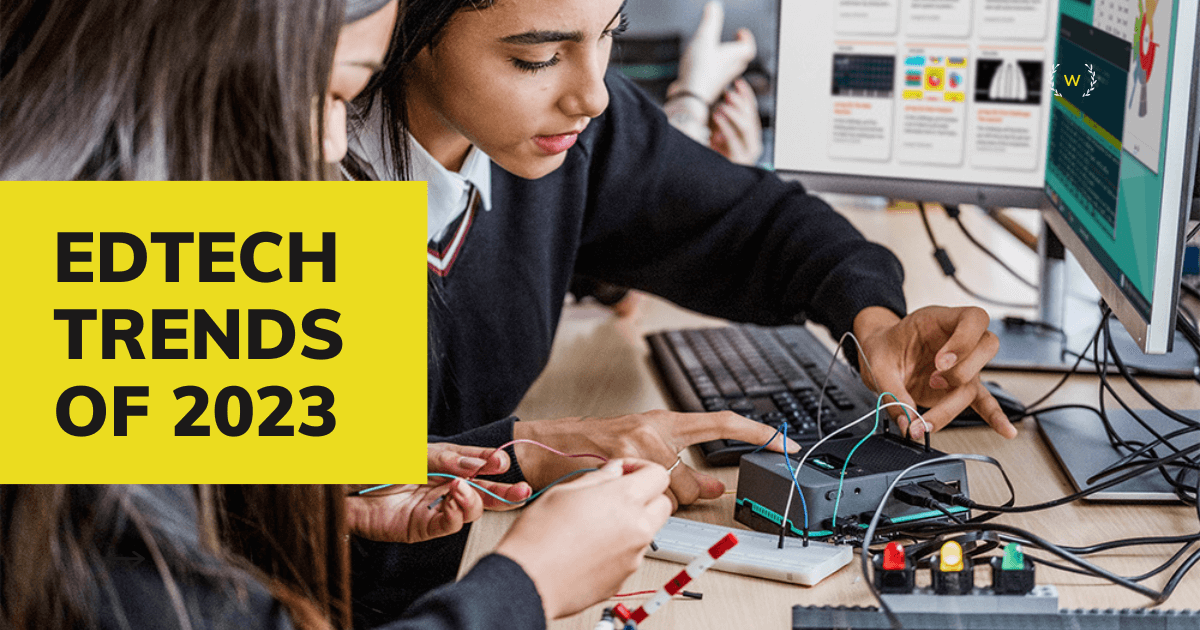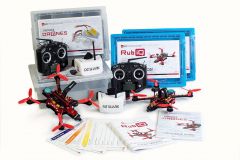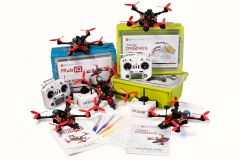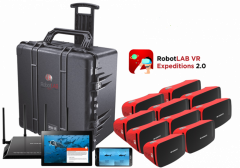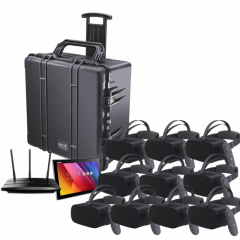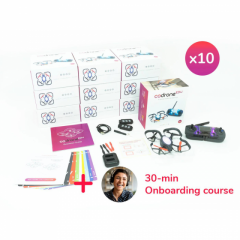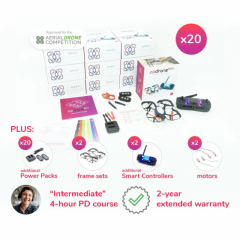As we look back on 2023, it’s easy to discern the trends in educational technology and innovative instructional approaches that would push the boundaries of pedagogy. Chalkboards and rote memorization faded further into the rearview mirror, replaced by groundbreaking trends reshaping how students learn and thrive. Here, we'll delve into some of the most impactful EdTech trends that defined last year—from the rise of gradeless classrooms and personalized learning to the tried-and-true technology that STEAM instructors continue to love. And, of course, we’ll even tackle the artificial elephant in the room: the increasing role of AI in every sector. The year 2023 is over, but the educational movements that shaped the year will impact students in 2024—and beyond.
Innovation station
While 2023 was a year full of innovation, one specific technology was so prominent that nothing else came close. We're talking, of course, about the latest developments in artificial intelligence (AI), many of which burst onto the scene for early adopters later in 2022 before exploding in popularity in the early days of 2023. Though AI affected thousands of workers across all fields, with 14% of employees experiencing “job displacement” or a shift in role due to AI, the education world saw some of the most notable changes. Almost every educational trend last year was influenced by the use of AI tools like ChatGPT and Google’s Gemini. Let’s start by taking a look at the rise of AI. Then, we’ll see what else happened in 2023 and what it means for the upcoming year.
Intelligence gets artificial
Large language models (LLMs), also known as AIs, are rapidly transforming the education landscape. Almost overnight, ChatGPT revolutionized what it means to create, to research, and to learn. For educators, the most immediate issue was how to prevent cheating. AI tools can create human-like essays on any topic in seconds, raising new concerns about academic integrity. This necessitated shifts toward assessments that evaluate critical thinking and analysis over rote memorization. Instead of relying only on essays or standardized testing, instructors can use projects, presentations, debates, or group work that require students to demonstrate their understanding and application of the material.
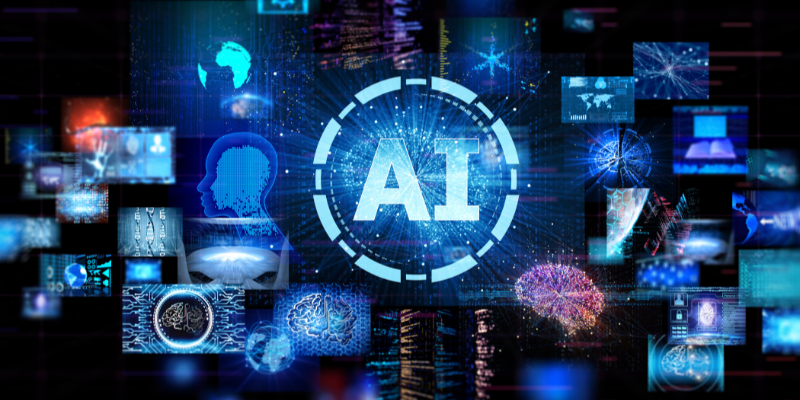
AI could even step in as a supporting tutor—although it cannot replace a human guide. Students might run their work through ChatGPT to receive instant feedback on grammar or structure. On the teacher’s side, AI can analyze student data and learning styles to suggest personalized activities or adjust lesson difficulty. It can write lessons or grade quizzes (though don’t forget to check its work!), saving educators valuable time and effort. While ethical challenges remain, AI could make education more personalized and effective.
Preparing for career-driven futures
Career and technical education (CTE) has gained significant traction in recent years, and enrollments in CTE courses only grew last year. In fact, over 12.3 million students were enrolled in CTE programs in the United States in 2023 alone. CTE courses, especially at the high school level, provide students with the practical knowledge they need to enter the workforce. Students graduate CTE courses equipped with technical skills that employers routinely seek, like coding, graphic design, or welding. These skills make them more competitive in the job market, regardless of their chosen field.
But does CTE actually help students prepare for the future? Great news—it does! Students in CTE programs have a 10% greater high school graduation rate than uninvolved students, and over 75% of CTE students “enroll in postsecondary education after high school.” With the emergence of AI, CTE has become even more important as parents and students scramble to find AI-proof technical skills. Recent developments in automation and tech have accelerated the demand for skilled workers in sectors like healthcare and IT. Whether students utilize their knowledge from CTE programs to join the workforce directly or enroll in further education, CTE prepares them to problem-solve, work in teams, and communicate well in any field.
Staying safe in cyberspace
The digital world—and kids’ use of devices—is still expanding rapidly, even in schools. Although we are big proponents of tech in the classroom, it is essential to guarantee students’ safety on the Internet. Plus, as AI advances, so too do the threats it poses, making robust cybersecurity more crucial than ever. This interplay led to a significant rise in the cybersecurity field in 2023.
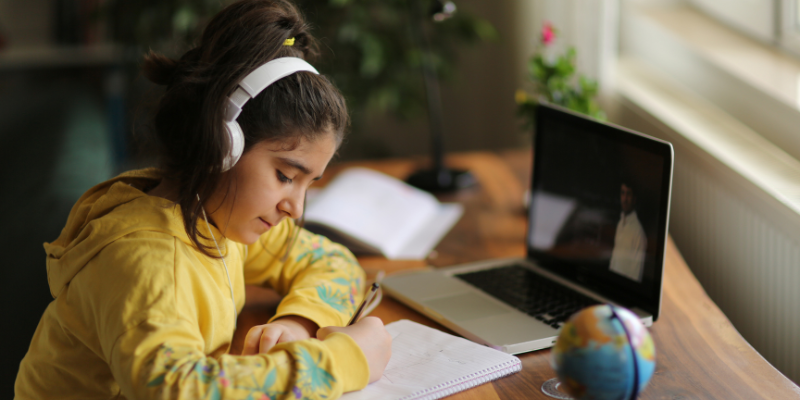
Many schools and universities are now incorporating cybersecurity concepts into their curricula. This ranges from basic online safety lessons in elementary school to advanced cybersecurity concepts in college. Students might prepare for a future career in cybersecurity while learning about protecting data from unauthorized access. At the same time, training programs help educators stay up to date on the latest cybersecurity threats and best practices. Although cybersecurity is relatively new in popularity, there are many opportunities for growth. Its ever-evolving nature means teachers must work together to ensure that future generations can safely navigate the digital world.
The power of pedagogy
While AI is causing a major shift in education and related fields, it will not replace teachers entirely. AI lacks the empathy and emotional intelligence required to nurture students in the way teachers can. Teachers also facilitate a safe environment for social-emotional learning and building interpersonal relationships, which AI cannot replicate. Most importantly, teachers inspire students to reach their full potential. Nothing is more motivating than a teacher who is genuinely excited about their subject and forms real relationships with their students. That's why, though AI can complement traditional teaching tools, teachers themselves remain at the heart of education.
Unfortunately, in 2023, many schools navigated a crisis of teacher retention. In the United States, educators are far more likely to experience anxiety than other professionals, resulting in teacher burnout. This constant state of chronic emotional and mental exhaustion prevents teachers from doing their jobs to the best of their ability. Long hours, demanding administrative tasks, and curricular pressures have created an unsustainable workload for many teachers, leaving them drained and unable to focus on the students.

Moving forward, alleviating teacher burnout is at the top of the priority list for many K-12 district leaders. Providing sufficient support and funding to teachers is only the first step to solving this ongoing crisis. But in the midst of the burnout blues, other significant educational trends appeared in 2023, including gradeless classrooms and an emphasis on SEL and personalized learning.
Reimagining the report card
The year 2023 saw more K-12 teachers going gradeless, shifting their mindsets from scores and rubrics to holistic learning. Written and video feedback were all the rage, and big names in education began to critique the 100-point grading scale as an unfair, often biased system. One teacher wrote on Twitter (X): “I wonder which of our teaching strategies would be at the top of this list if we measured curiosity, love of learning, imagination, and self-efficacy instead of (or along with) acquisition of content knowledge.” It seems that rote memorization of knowledge—and assessment thereof—is falling by the wayside.
Enter the gradeless classroom. Going gradeless means prioritizing intrinsic motivation and mastery above standardized test scores. Students are free to explore, experiment, and make mistakes without pressures of a looming grade, cultivating an anxiety-free learning environment. Instead of grades, self-assessment is the order of the day. Kids are encouraged to develop their critical thinking and self-evaluation skills, identifying their own strengths and weaknesses and setting learning goals.

But it’s not all sunshine and rainbows. The external pressure of grades can be a valuable incentive, so removing grades may mean, for some students, removing motivation. Beyond that, many college admissions processes require standardized tests, and even parents may balk at the idea of ending the school year without knowing whether their kid should be grounded or taken out for ice cream. Teachers, too, must shift their mindsets as they adapt their pedagogical practices to the new system. So, is the switch worth it? That’s a question each school must answer for itself.
Personalizing student wellness
The rise of gradeless classrooms is linked to recent attention on student wellbeing. The pandemic shone light on neglected areas of student wellness, including the stress they faced during remote learning. In 2023, the pandemic continued to impact classrooms as teachers dealt with students’ knowledge gaps, decreased attention spans, and heightened anxiety. Going gradeless can reduce anxiety, but educators are also testing additional solutions. Perhaps the most widespread of these educational trends has been an emphasis on social-emotional learning (SEL).

SEL recognizes that healthy individuals are typically better learners. This newer focus is not a rejection of academic excellence but an acknowledgement that it thrives on healthy roots. SEL equips students with key tools to manage stress, navigate relationships, and build resilience—skills that are crucial in tackling academic challenges. Prioritizing student wellbeing through SEL means creating an environment in which students are treated as whole people.
However, student wellbeing requires more than SEL to maintain it. Teachers are experimenting with flexible schedules, diverse teaching styles, and tech tools to accommodate each student’s unique strengths and challenges. Personalized learning is also on the rise as educators battle addictive algorithms. Social media delivers catered content via an algorithm, so why not do the same in the classroom?

Personalized learning also helps students learn independently, since they’re fueled by curiosity. This approach fosters deeper engagement as students invest their own ideas and motivations directly into their work. It is one of those EdTech trends that nurtures individual talents and celebrates all their diverse educational journeys—something that may help students, like Eduporium’s founder, who dropped out of high school to pursue his own path.
EdTech trends: Teachers’ favorites
As an EdTech provider, we get a front row seat to teachers’ exciting new projects, and in 2023, you all had some great ideas! But a few EdTech trends stood out. Classroom drones increased in popularity, combining the appeal of coding with the potential career of piloting. In school makerspaces, 3D printing also had another strong year, helping children apply their knowledge of modeling, design, and engineering to make ideas into physical objects. And virtual reality (VR) systems engaged children in multi-sensory learning experiences. Let’s dive deeper into the most popular types of EdTech solutions in 2023.
Going higher with drones
The drone world saw a shift as DJI discontinued its popular Tello EDU in the spring of 2023. But the impact of drones in education only grew. In recent years, drones have traveled beyond hobbyist circles and landed in classrooms or afterschool clubs as valuable learning tools. And, although drones have firmly established their value in education, their popularity continued to soar in 2023. Some drone kits require the students to assemble the drones themselves, teaching future-focused engineering skills, while others highlight coding. We noticed a particular interest in coding drones in 2023, as programming skills remained at the top of the list of STEM learning priorities.
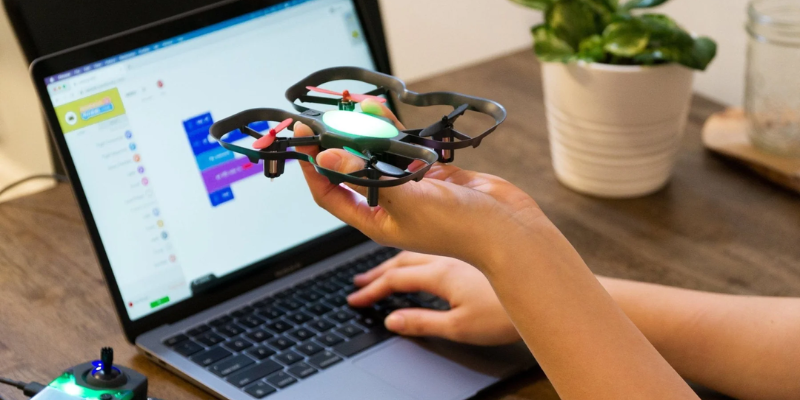
Either way, drones offer a multi-dimensional perspective on STEM—and help prepare students for plenty of relevant careers. Beyond capturing stunning aerial footage (great practice for any future photographers and architects), drones can enrich geography lessons by helping classes map the surrounding landscape. Using drones can also reinforce environmental science principles as kids observe those big-picture connections between different habitats. No matter which direction your students choose to fly, they’ll be able to explore dozens of career options.
The shifting realm of makerspaces
In the meantime, schools have continued to transform libraries and spare classrooms into makerspaces, integrating MakerEd into much of the curriculum. The Maker Movement has cemented itself as an integral piece of STEAM learning, but each school year brings new opportunities to refresh and hone the art of maker education. In 2023, the popularity of Glowforge 3D laser printers showed us that makerspaces—along with other areas of the curriculum—were moving towards personalization. When kids see their designs come to life, it sparks motivation, encouraging them to take ownership of their learning.
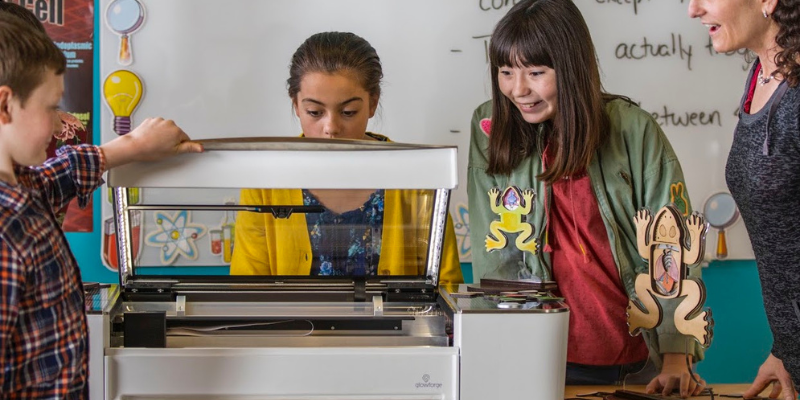
After all, 3D printing creates the perfect opportunity to make learning tangible, empowering students to move beyond textbooks and worksheets. Printers like Glowforge’s desktop powerhouses enable students to transform what they learned from their lessons into custom gadgets and models. Perhaps their creations could make lessons more accessible with tools like tactile maps or Braille blocks. Or maybe teachers could assess student understanding by assigning 3D printing projects, combating AI plagiarism concerns while simultaneously incorporating personalized learning principles. It’s no accident that 3D printing has enjoyed a rise concomitant with that of personalized learning.
Take the Miss Frizzle route with VR
EdTech trends in 2023 also ventured into new virtual worlds, harnessing the power of VR and AR to boost engagement and retention. From exploring the works of great impressionists in far-off museums to going inside a cell in the human body, VR classrooms transport students beyond the limitations of the physical space, enhancing their understanding of cross-curricular STEAM concepts. By engaging multiple senses, like sight and sound, VR creates a deeper connection with the learning material. Students feel like they’re experiencing content firsthand rather than passively consuming information, reinforcing their memory.
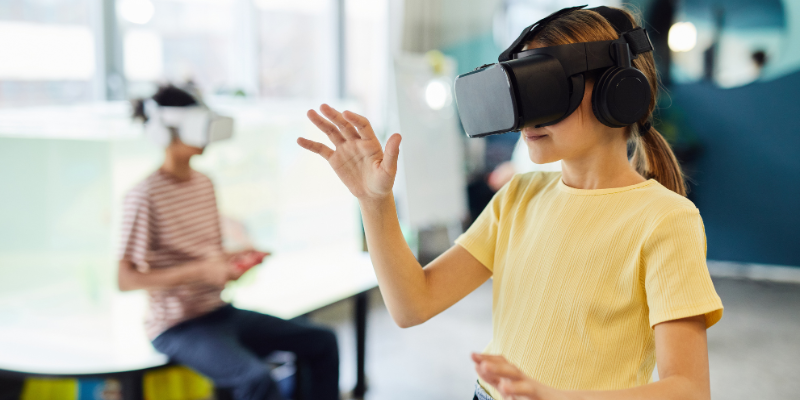
The immersive nature of VR resources not only enhances learning but also fosters empathy and deeper understandings of diverse perspectives. By simulating different realities, VR allows children to understand the world through others’ eyes. Perhaps that’s why VR was so big in 2023—it reinforces the social-emotional principles already gaining traction. Active participation is also encouraged as children utilize VR systems, like RobotLAB’s VR Expeditions and its pop-up prompts and questions that spark discussion.
Looking to educational trends of 2024
Last year was filled with innovation, and much of the world’s attention was rightfully focused on AI. But we also saw EdTech trends take turns toward cybersecurity and CTE programs, both of which prepare high school students for the challenges they’ll face after graduation. To further prepare them, teachers also took an interest in social-emotional learning, helping kids bounce back from the emotional turmoil of the pandemic. As student wellbeing came into focus, personalized learning kept students engaged by connecting lessons closer to their interests. Tools like AI, VR systems, and 3D printers made it possible to personalize, and gradeless classrooms meant more freedom for independent learning. No matter what the world of education faces in 2024, we all have the best interests of children in mind, so let’s move forward together into another great year of STEAM!
If you want to stay up to date with what’s new in EdTech, subscribe to our newsletter to get articles like this one sent straight to your inbox. You can also follow us on both Twitter (X) and Instagram, or contact us with any questions! Also, don’t forget to apply for our monthly grants to get some of these innovative tools into your classroom.



